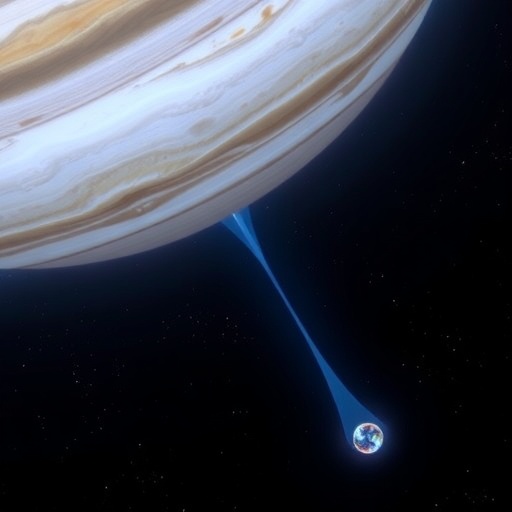In an extraordinary breakthrough, researchers from the University of Minnesota Twin Cities have unveiled a new type of plasma wave present in Jupiter’s aurora, a monumental discovery that not only broadens our understanding of the gas giant’s atmospheric phenomena but also enhances our knowledge of similar processes occurring on other planets throughout the solar system. This vital research is published in the journal Physical Review Letters, a highly regarded, peer-reviewed journal within the scientific community, ensuring the findings meet rigorous academic standards.
This game-changing observation was made possible through data collected by NASA’s Juno spacecraft, which conducted an unprecedented low orbit over Jupiter’s north pole. Prior to this mission, the study of the northern polar regions of Jupiter was limited, largely due to technological constraints. The Juno spacecraft’s unique orbit has allowed scientists to gather direct measurements and analyze plasma dynamics in ways that were previously unattainable, thus opening a new chapter in planetary science.
As one of the lead researchers, Ali Sulaiman, who is an assistant professor in the University of Minnesota School of Physics and Astronomy, emphasizes, “The James Webb Space Telescope has provided us with stunning infrared images of Jupiter’s aurora, but Juno stands out as the first mission to position itself in a polar orbit around the planet.” With Juno at the helm, researchers can delve deeper than ever into the complex interactions between plasma and magnetic fields in the environment of Jupiter.
The complexity of the plasma surrounding magnetized planets like Jupiter is notable. Plasma, a state of matter consisting of superheated ions and electrons, can manifest in various forms due to the influence of self-generated magnetic fields and external forces. The existence of auroras is one such phenomenon caused by energetic particles spiraling toward a planet’s atmosphere, igniting the gases and producing vibrant colors. On Earth, we are accustomed to associating auroras with brilliant greens and blues, intricately intertwined with our planet’s magnetic shield. However, Jupiter’s auroral display typically remains invisible to the naked eye, necessitating the use of ultraviolet and infrared instruments for observation.
The research team’s fascinating analysis has unveiled a previously unknown form of plasma wave resulting from the extremities of Jupiter’s polar environment—characterized by very low plasma density and the intense strength of its magnetic field. These unique conditions lead to plasma waves that exhibit exceptionally low frequencies, a striking contrast to the plasma phenomena observed around Earth. This discovery not only illustrates the diversity of plasma behaviors across different planetary bodies but also reinforces the significance of understanding these dynamics as we strive to comprehend the workings of our universe.
In addition to the exciting discovery of low-frequency plasma waves, the study also provides critical insights into the distinctive characteristics of Jupiter’s magnetic field. Unlike Earth, where auroras typically form in a donut shape around the polar regions, Jupiter’s magnetic field facilitates an influx of charged particles directly into its polar cap. This distinct behavior warrants further investigation, as it may reveal underlying principles governing magnetic fields and plasma interactions across various planetary systems.
Juno continues to transmit invaluable data, and researchers are eager to harness this information to explore the newly discovered plasma regime further. Ali Sulaiman and his team, which includes esteemed colleagues like Robert Lysak, a notable expert in plasma dynamics, alongside other collaborators from the University of Iowa and the Southwest Research Institute, are excited about the research possibilities that lay ahead.
Groundbreaking discoveries of this magnitude rely heavily on funding and support of research institutions, and this endeavor is no exception. The research has been made possible through funding from NASA and the National Science Foundation (NSF), signifying the importance of collaboration between scientific bodies in deepening our understanding of celestial phenomena.
In scrutinizing the intricacies of Jupiter’s aurora and its associated plasma dynamics, this research holds profound implications not only for planetary exploration but also for our comprehension of the protective mechanisms provided by Earth’s own magnetic field. By understanding how other planets such as Jupiter interact with solar wind and cosmic rays, scientists may glean insights that translate into better predictive models for space weather on Earth.
This pivotal study paves the way for subsequent research initiatives aimed at understanding the complexities of particle interactions in auroras, thereby enhancing scientific literacy concerning space and atmosphere phenomena. The academic community now stands on the precipice of a new era in plasma physics and planetary science, with the findings from the University of Minnesota set to inspire future explorations and discoveries, potentially reshaping our understanding of our solar system and beyond.
As the research continues, there is anticipation radiating through the scientific community regarding the potential for additional findings and the further development of theoretical models that rest upon this newly uncovered plasma regime. As more data becomes available, the hope is for a profound shift in our understanding of planetary atmospheres and the intricate dance of mechanics at play within them.
In summary, the discovery of a new type of plasma wave in Jupiter’s aurora contributes significantly to our understanding of extraterrestrial plasma phenomena. It exemplifies the remarkable work being carried out by dedicated researchers who are tirelessly investigating the dynamic systems of our universe. As we harness the data from Juno and other exploratory missions to Jupiter, the excitement surrounding each new revelation fuels the thirst for knowledge in an ever-expanding cosmos.
Subject of Research: Plasma waves in Jupiter’s aurora
Article Title: New Plasma Regime in Jupiter’s Auroral Zones
News Publication Date: 16-Jul-2025
Web References: School of Physics and Astronomy’s website
References: Physical Review Letters
Image Credits: University of Minnesota
Keywords
Plasma waves, Jupiter, aurora, planetary science, plasma dynamics, magnetic field, research, Juno spacecraft.




